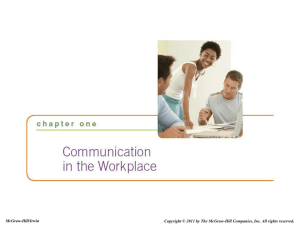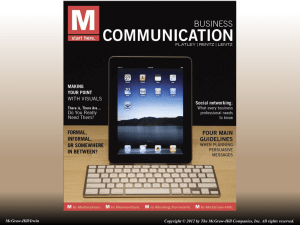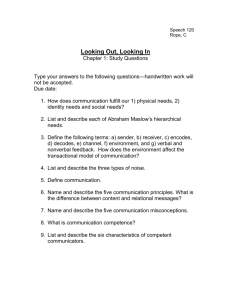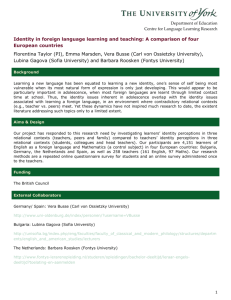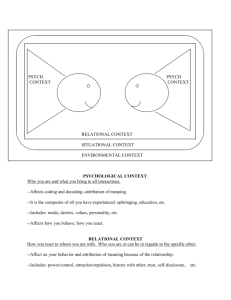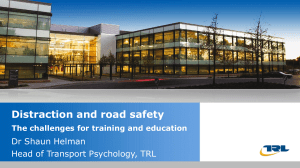Phoenix College - Introduction to Communication
advertisement
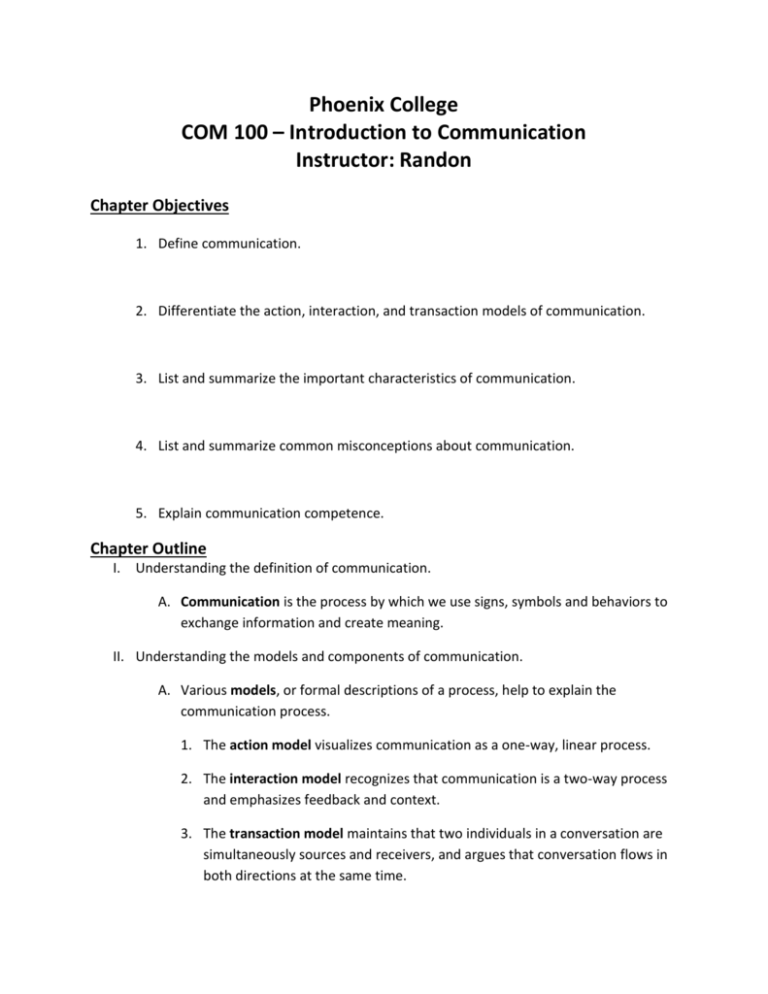
Phoenix College COM 100 – Introduction to Communication Instructor: Randon Chapter Objectives 1. Define communication. 2. Differentiate the action, interaction, and transaction models of communication. 3. List and summarize the important characteristics of communication. 4. List and summarize common misconceptions about communication. 5. Explain communication competence. Chapter Outline I. Understanding the definition of communication. A. Communication is the process by which we use signs, symbols and behaviors to exchange information and create meaning. II. Understanding the models and components of communication. A. Various models, or formal descriptions of a process, help to explain the communication process. 1. The action model visualizes communication as a one-way, linear process. 2. The interaction model recognizes that communication is a two-way process and emphasizes feedback and context. 3. The transaction model maintains that two individuals in a conversation are simultaneously sources and receivers, and argues that conversation flows in both directions at the same time. B. There are many components at play in these models of communication. 1. The source is the individual who wishes to communicate his or her thought. 2. The encoding process involves putting your idea into a form or gesture that can be understood by others. 3. The message consists of the verbal and/or nonverbal elements of communication to which people give meaning. 4. The channel is the means by which the message travels. 5. The receiver is the recipient of the message. 6. The decoding process involves interpreting the message. 7. Noise is anything that interferes with a receiver’s ability to attend to the message. a. Physical noise involves a distraction related to the external environment. b. Psychological noise involves a distraction related to the mind. c. Physiological noise involves a distraction related to the body. 8. Feedback involves the various verbal and nonverbal responses to the message. 9. Context is the environment in which communication takes place. a. The physical context reflects where you are in terms of location. b. The psychological context involves factors that influence the communicators’ minds, for example, the formality of the situation. <Handout> III. Realizing that communication has many important characteristics. A. Communication relies on multiple channels. 1. Channel-rich contexts incorporate multiple communication channels at one time, for example, face-to-face communication. 2. Channel-lean contexts are environments that use relatively few channels, for example, text messaging. B. Communication passes through perceptual filters, which include our experiences, biases and beliefs. 1. Perceptual filters influence how two people understand words. 2. Factors such as ethnic and cultural background, gender, religion, socioeconomic status, intelligence, education, etc. color our perception. C. People give communication its meaning through the use of symbols. 1. A symbol is a representation of an idea. 2. Meaning resides in people, not in words, because words are merely symbols. D. Communication has literal meanings and relational implications. 1. The content dimension is the literal information that is being communicated. 2. The relational dimension gives cues about the nature of the relationship between the communicators. 3. Metacommunication is communication about communication, and is a way that people can distinguish between content and relational dimensions. E. Communication sends messages, whether intentional or unintentional 1. Some researchers believe that only deliberate, intentional messages should be classified as communication. 2. Others believe that “you cannot not communicate” which suggests that everything one does has communicative value. F. Communication is governed by rules that suggest what behaviors are required, preferred or prohibited in various social contexts. 1. Explicit rules are clearly articulated to message recipients. 2. Implicit rules are rules that members of a group should know and follow, even though no one has formally expressed them. IV. Identifying and dispelling the common myths regarding communication practices. A. “Everyone is a communication expert” is false because having experience with something is not the same as having expertise. B. “Communication will solve any problem” is false because sometimes we will have to agree to disagree. C. “Communication can break down” is false because the problem lies not with communication itself, but with the way individuals are using it. D. “Communication is inherently good” is false because communication is not good or bad in and of itself—it is how we use communication that makes it positive or negative. E. “More communication is always better” is false because sometimes less is more, and the effectiveness of communication matters more than the amount of communication. V. Communication competence involves communicating in ways that are effective and appropriate in a given situation. a. What are employers looking for? b. HEAR Model – Health, Employment, Academics, Relationships <Handout>
